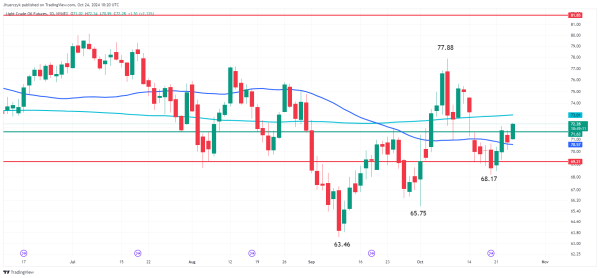Oil News: Crude Futures Rally as Middle East Conflict Sparks Supply Fears
Crude Oil Futures Rally as Geopolitical Tensions Lift Market Sentiment
Crude oil futures are pushing higher on Thursday, with light crude breaching a key technical retracement zone between $71.63 and $69.21. The market also gained strength after crossing above the 50-day moving average at $70.58 earlier in the week, now acting as crucial support. Traders are closely eyeing a potential move toward the 200-day moving average at $73.01, which may serve as initial resistance. If buying momentum builds, this level could act as a trigger for further upside.

At 10:34 GMT, Light Crude Oil futures are trading $72.16, up $1.39 or +1.96%.
Middle East Tensions and Supply Fears Drive Oil Prices
Oil prices have surged over 1% on Thursday, reversing some of the previous session’s losses. Geopolitical concerns are driving the rally, particularly heightened tensions between Israel and Hezbollah, as well as reports of North Korean troops assisting Russia in Ukraine. These developments have reignited fears of supply disruptions, particularly in the Middle East—a critical region for global oil flows.
This geopolitical uncertainty, coupled with anxiety over potential U.S. policy shifts ahead of the presidential election, has created volatility. While the market had fallen over 7% last week due to oversupply concerns, it has since recovered roughly 4%, reflecting ongoing market jitters over potential supply risks.
U.S. Crude Inventories Rise Sharply
On the domestic front, U.S. crude oil inventories jumped by 5.5 million barrels last week, far exceeding expectations for a 270,000-barrel increase. This rise is largely attributed to higher imports and increased refinery activity following seasonal maintenance. Despite this bearish data, persistent fears of Middle East supply shocks helped stabilize prices, preventing a significant pullback.
The increase in inventories has pressured prices slightly, but it remains overshadowed by the broader geopolitical backdrop. Additionally, a rising U.S. dollar, which has reached its highest level since July, further weighed on oil demand from buyers using other currencies.
Saudi Arabia and GCC Prepare for Production Increase
Looking beyond immediate price movements, Saudi Arabia is reportedly preparing to abandon its unofficial target of $100 per barrel, which could result in a production increase as early as December. This shift will likely boost market share and increase global supply, contributing to economic growth across the Gulf Cooperation Council (GCC) states.
According to a Reuters poll, Saudi Arabia’s economic growth is projected to accelerate to 4.4% in 2025, supported by higher oil output, up from an expected 1.3% this year. The UAE is expected to lead the region, with its economy forecasted to grow 4.9% in 2025, as it capitalizes on increased production and a more diversified economy.
Market Forecast: Bullish in the Short Term with Key Resistance Ahead
Crude oil futures are expected to maintain a bullish bias in the short term, driven by ongoing geopolitical tensions and technical momentum. Prices are likely to test resistance around the 200-day moving average at $73.01.
If this level is breached with strong volume, prices could extend gains toward $75 or higher. However, if tensions in the Middle East ease or U.S. crude stock builds continue to exceed expectations, the market may face renewed downward pressure.
In the near term, the outlook remains cautiously bullish, with geopolitical risks playing a pivotal role in price direction.